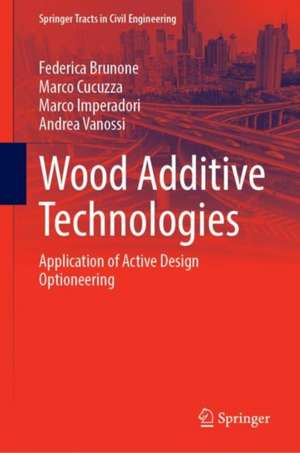Wood Additive Technologies: Application of Active Design Optioneering: Springer Tracts in Civil Engineering
Autor Federica Brunone, Marco Cucuzza, Marco Imperadori, Andrea Vanossien Limba Engleză Hardback – 26 aug 2021
Din seria Springer Tracts in Civil Engineering
- 18%
 Preț: 1234.00 lei
Preț: 1234.00 lei -
 Preț: 256.15 lei
Preț: 256.15 lei - 18%
 Preț: 787.15 lei
Preț: 787.15 lei - 15%
 Preț: 590.95 lei
Preț: 590.95 lei - 18%
 Preț: 1117.82 lei
Preț: 1117.82 lei - 15%
 Preț: 595.86 lei
Preț: 595.86 lei - 18%
 Preț: 1023.35 lei
Preț: 1023.35 lei - 20%
 Preț: 754.37 lei
Preț: 754.37 lei - 18%
 Preț: 1122.56 lei
Preț: 1122.56 lei - 18%
 Preț: 726.37 lei
Preț: 726.37 lei - 18%
 Preț: 1120.99 lei
Preț: 1120.99 lei - 18%
 Preț: 956.03 lei
Preț: 956.03 lei - 18%
 Preț: 1579.49 lei
Preț: 1579.49 lei - 15%
 Preț: 645.79 lei
Preț: 645.79 lei - 18%
 Preț: 1119.38 lei
Preț: 1119.38 lei - 18%
 Preț: 1121.55 lei
Preț: 1121.55 lei - 18%
 Preț: 1614.21 lei
Preț: 1614.21 lei - 18%
 Preț: 1002.75 lei
Preț: 1002.75 lei - 15%
 Preț: 640.24 lei
Preț: 640.24 lei - 18%
 Preț: 954.62 lei
Preț: 954.62 lei - 18%
 Preț: 1113.71 lei
Preț: 1113.71 lei - 18%
 Preț: 948.47 lei
Preț: 948.47 lei - 15%
 Preț: 645.47 lei
Preț: 645.47 lei - 15%
 Preț: 667.86 lei
Preț: 667.86 lei - 18%
 Preț: 1225.31 lei
Preț: 1225.31 lei - 18%
 Preț: 960.42 lei
Preț: 960.42 lei - 18%
 Preț: 947.04 lei
Preț: 947.04 lei - 18%
 Preț: 1024.08 lei
Preț: 1024.08 lei - 15%
 Preț: 643.48 lei
Preț: 643.48 lei - 15%
 Preț: 636.45 lei
Preț: 636.45 lei - 18%
 Preț: 1119.24 lei
Preț: 1119.24 lei - 18%
 Preț: 1383.00 lei
Preț: 1383.00 lei - 15%
 Preț: 597.26 lei
Preț: 597.26 lei - 18%
 Preț: 1416.12 lei
Preț: 1416.12 lei - 18%
 Preț: 1003.70 lei
Preț: 1003.70 lei - 18%
 Preț: 1030.38 lei
Preț: 1030.38 lei - 18%
 Preț: 1012.84 lei
Preț: 1012.84 lei - 15%
 Preț: 586.05 lei
Preț: 586.05 lei - 18%
 Preț: 1241.25 lei
Preț: 1241.25 lei - 15%
 Preț: 606.82 lei
Preț: 606.82 lei - 15%
 Preț: 581.65 lei
Preț: 581.65 lei - 15%
 Preț: 522.56 lei
Preț: 522.56 lei - 18%
 Preț: 1025.79 lei
Preț: 1025.79 lei - 18%
 Preț: 944.82 lei
Preț: 944.82 lei
Preț: 489.48 lei
Nou
Puncte Express: 734
Preț estimativ în valută:
93.69€ • 101.80$ • 78.75£
93.69€ • 101.80$ • 78.75£
Carte tipărită la comandă
Livrare economică 21 aprilie-05 mai
Preluare comenzi: 021 569.72.76
Specificații
ISBN-13: 9783030781354
ISBN-10: 3030781356
Ilustrații: XV, 181 p. 143 illus., 139 illus. in color.
Dimensiuni: 155 x 235 mm
Greutate: 0.46 kg
Ediția:1st ed. 2021
Editura: Springer International Publishing
Colecția Springer
Seria Springer Tracts in Civil Engineering
Locul publicării:Cham, Switzerland
ISBN-10: 3030781356
Ilustrații: XV, 181 p. 143 illus., 139 illus. in color.
Dimensiuni: 155 x 235 mm
Greutate: 0.46 kg
Ediția:1st ed. 2021
Editura: Springer International Publishing
Colecția Springer
Seria Springer Tracts in Civil Engineering
Locul publicării:Cham, Switzerland
Cuprins
Existing building transformation: current drivers, issues, and possibilities.- A new taxonomic perspective on wood-based technologies for the transformation of the AEC sector.- An innovative method for the management of the building process.- A validation opportunity: case-studies analysis and outcomes on the application of the method on real buildings.- From Cognitive Buildings to Digital Twin: the frontier of digitalization for the management of the built environment
Notă biografică
Prof. Marco Imperadori is full professor of Building Engineering at Politecnico di Milano, Italy. Lecturer and visiting professor in many universities and institutions worldwide, his research interests focus on high energy-efficient buildings, structure/envelope building systems, and sustainability. He was responsible for Politecnico di Milano in the building Resilience Network Android (EU-LLP), and currently serves as Rector’s Delegate for the Far East representing Politecnico di Milano in Asia. He represents Politecnico di Milano in the Active House Alliance board of advisory committee.
Textul de pe ultima copertă
The book encodes a vision for the actively sustainable management and development of the built environment by referring to the application of timber-based construction systems as additive solutions for the multi-purpose improvement of existing buildings. It translates this vision into an innovative methodology for the management of the entire building process – from design to production, operation, and maintenance - and the assessment of timber-based construction performances across the whole building life-cycle. This approach is based on a multi-dimensional analysis, which starts from the structure of the Active House (AH) protocol, improved through information-integrated digital environments and multi-criteria evaluation methods, such as BIM and Design Optioneering. During the design stage, indeed, it analyzes and compares different design choices, according to the DO method, until the definition and validation of the “As-Built” step, while in the operational phase, it refers to sensors-retrieved data to show the evolution of the building behaviour, accounting for real users’ interaction, building performances decay and needs of maintenance, defining the digital twin of the building: a real Cognitive Building. Finally, the application of this methodology identifies innovative models of processes, products, and design of wood-based construction technologies, suitable to satisfy the needs of the 2D/3D construction layering for the sustainable transformation of the built environment.
Caracteristici
Sheds light on wood-based technologies for buildings transformation Showcases advances and innovations in the wood construction sector Provides innovative approaches to inspire policymakers, architects and building designers
